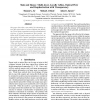18 search results - page 2 / 4 » Divide-and-Conquer Strategies for Estimating Multiple Transp... |
CVPR
1996
IEEE
14 years 11 months ago
1996
IEEE
This paper describes a new method for estimating optical flow that strikes a balance between the flexibility of local dense computations and the robustness and accuracy of global ...
ICIP
2003
IEEE
14 years 11 months ago
2003
IEEE
In this paper, a new methodology for optical flow estimation that is able to represent multiple motions is presented. To separate motions at the same location, a new frequency-dom...
ICRA
2009
IEEE
13 years 7 months ago
2009
IEEE
For haptic devices, compensation of the robot's gravity is a frequent strategy with the aim to reduce interaction forces between robot and human in zero-impedance control. How...
IJCV
2007
13 years 9 months ago
2007
The neural mechanisms underlying motion segregation and integration still remain unclear to a large extent. Local motion estimates often are ambiguous in the lack of form features,...
NIPS
1992
13 years 11 months ago
1992
Neurons in area MT of primate visual cortex encode the velocity of moving objects. We present a model of how MT cells aggregate responses from V1 to form such a velocity represent...

